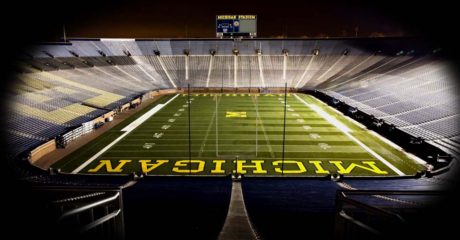 Single wing QB Denard Robinson
Single wing QB Denard Robinson
Well, last night was frustrating. Not only because we lost, but because the loss was self-inflicted. Five turnovers, blown coverages, bad coaching decisions. Michigan clearly seemed to be the more talented team, but luckily for Iowa, talent doesn’t always win.
I would be remiss if I started this post with anything but a discussion of Rich Rodriguez’s decision to go with freshman Denard Robinson on the last drive in the fourth quarter. That was the biggest decision of the night – and the worst, in my opinion – and it might have cost Michigan the game.
Assuming Rodriguez benched starter Tate Forcier because of Forcier’s performance (8/19 for 94 yards and an INT, 8 carries for 26 yards), it was an indefensible decision. Two of Michigan’s victories this season (Notre Dame and Indiana) are the direct result of Forcier’s late-game heroics. Last week’s near-victory against Michigan State came after Michigan was down 20-6 halfway through the fourth quarter and Forcier directed two touchdown drives. Meanwhile, backup Denard Robinson has had a couple electrifying TD runs while failing to pass the ball efficiently in spot duty this season. Prior to last night, Robinson was 4/11 for 57 yards, zero touchdowns, and 2 interceptions.
When Robinson entered the game in the second-to-last series last night, Forcier wasn’t performing well. Michigan needed a spark. I understand that. Robinson completed two short passes on that drive and ended the series with a short TD run. The offense needed a spark? Mission accomplished.
But with 1:30 left and Michigan needing to go 80 yards with no timeouts, Rodriguez shouldn’t have played the running quarterback, no matter how poorly Forcier had played to that point. Robinson is clearly a subpar passer and showed it when he badly overthrew a bracketed Junior Hemingway that resulted in the game-ending interception. Robinson finished the game 3/4 for 30 yards and 1 interception, which raised his passer efficiency rating to 55.39 on the season. By comparison, Forcier’s PER is 133.11. Furthermore, Nick Sheridan’s PER in 2008 was 81.08. That’s right – Robinson is a significantly worse passer than Nick Sheridan. So not only should Forcier have been in the game at the end, but one could make the argument that Sheridan should have been in there instead of Robinson, too.
Now, some theories suggest that Forcier got benched because he and Rodriguez had words on the sideline. I didn’t see evidence of that during the telecast, but it’s possible. If that’s true and Rodriguez was using the benching to teach Forcier a lesson, that might be a good reason. But if it was just based on their play, Forcier should have been on the field.
Otherwise, Michigan turned the ball over too much. The Wolverines fumbled, threw interceptions, muffed punts, etc. They achieved just about every method of turning the ball over. In between playing solid run defense (Iowa averaged 2.4 yards per rush), running the ball well (4.3 yards per carry), and playing decent pass coverage most of the time, Michigan gave the ball away too many times. You will rarely see a team win the game when they’ve turned the ball over four or five times.
Defensively, former starting cornerback Boubacar Cissoko was suspended for the game due to a violation of team rules. In his place, starting strong safety Troy Woolfolk moved over to cornerback. The starting safeties were walk-on Jordan Kovacs and redshirt sophomore Mike Williams. Woolfolk played better than either Cissoko or J.T. Floyd had earlier in the year, but Williams especially blew some coverages at key times. I can’t blame him too much, as he’s been playing close to the line for the past two years as almost a glorified outside linebacker. Michigan fans shouldn’t expect that he’ll be a great center fielder in his first extended playing time at the position, but he does have good speed and he’s a solid tackler. If Woolfolk can solidify the cornerback position, I think Williams and Kovacs might be sufficient at the safety spots.
Offensive game ball goes to…the offensive line. The offensive line got destroyed last week against Michigan State, but center David Moosman (replacing the injured David Molk) made good snaps for the entire game and Michigan got a solid push from their undersized line against a strong Iowa front seven.
Defensive game ball goes to…Donovan Warren. He opened the game with a pick six and played pretty well for the rest of the game. He did get beat on a 47-yard pass on a 3rd-and-24, but that was at least partly because Mike Williams was slow to help from his safety position.
Let’s see less of this guy on offense…Denard Robinson. Please, God, do not allow Rodriguez to put him on the field to pass the ball in key situations. He has a lower PER than Nick Sheridan and he can’t run the full offense. Not only is he unable to pass the ball or even run the famed read option, but he also hasn’t taken a single snap from under center (if I recall correctly) in the I-formation, which is the best way to run Brandon Minor. A large portion of the playbook goes out the window with Robinson in the game, and it’s just QB draw, QB sweep right, QB draw, QB sweep left, QB draw, QB sweep right, onward to infinity.
Let’s see less of this guy on defense…Boubacar Cissoko and J.T. Floyd. The rest of the defense played well except for the safeties, but there’s no help coming for them. Kovacs and Williams need to improve with more experience and more reps. Meanwhile, while Cissoko didn’t play at all and Floyd played sparingly, Woolfolk held his own at the cornerback position. Hopefully Greg Robinson keeps Woolfolk at corner and is able to coaches up those other safeties.





